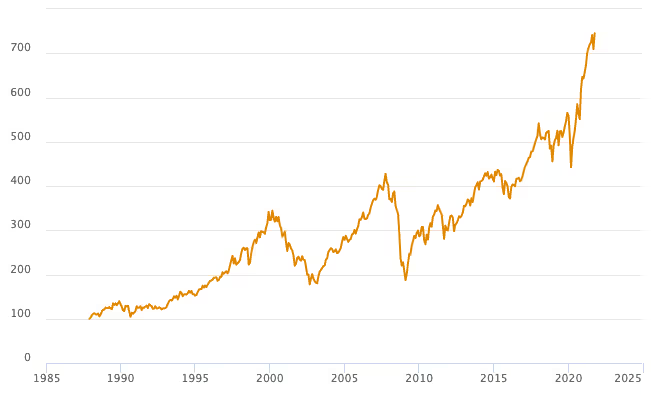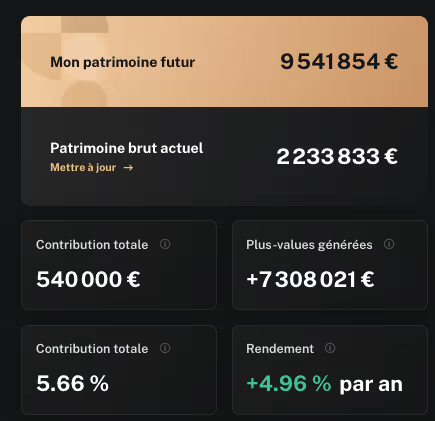


Predicting the future with Monte Carlo



Inspired by wealth management, our new Monte Carlo simulation allows you to plan the future trajectory of your assets.
Finary's mission is to democratize tailor-made management through technology. To do this, we were inspired by the best: wealth management. Only accessible to the most fortunate (Benjamin Durand spoke about it during the First Finary Talk), this high-end management allows you to plan your future in the best possible way.
Monte Carlo simulation is one of the tools most used by these wealth managers. In particular, they use it to build tailor-made allowances or to make back-testing strategies. Complex and difficult to implement for individual investors, it was previously reserved for an elite.
Today, we are making this simulation accessible to everyone. Co-developed with experts who have worked on these models for large fortunes at Goldman Sachs & Barclays, it will allow all Finary users to better anticipate the future. Raising the curtain on a real world premiere made in Finary.
The Monte Carlo simulation
The principality of Monaco has become world famous for its casinos, its mild fiscal climate and its F1 Grand Prix. Inspired by games of chance, Monte Carlo is in fact a probabilistic method: it consists in simulating thousands of scenarios, then combining them in order to extract general trends. Used in many areas, it is very popular with wealth managers.

The algorithm uses the historical performance of asset classes to launch 5000 successive scenarios. The repetition of these random simulations makes it possible to obtain a statistically reliable result. The distribution obtained makes it possible to create a confidence interval within which the investor can project himself in order to plan for the future.
This method is much more reliable than using average performance by asset class. If you apply an arbitrary return to an asset (ex: 8% /year for shares), it can only increase. Its growth will end up being exponential. This is where the Monte Carlo magic happens: simulation allows you to have negative performances, which is obviously much more realistic!
Are you lost? Let's take a concrete example with a subject that we are all passionate about: the weather. We want to analyze the weather of a city over 100 consecutive days. The weather can be nice, cloudy, or rainy. Now let's compare a simulation based on averages with Monte Carlo:
- Simulation with averages : taking the average of all days, we would find a mixed result: it is “generally” cloudy.
- Monte Carlo simulation: by analyzing the distribution, we can give much more granular information. In the worst case, there will be 50 days of sunshine per year, and 100 in the best case.
In order to provide you with a simulation that is as accurate as it is useful, we went a long way! In a classic Monte Carlo, the results are sampled using a Normal (or Gausian) law. However, this distribution has limits: it has a tendency to override scenarios located at the extremes (called Tails in English). Again, this approach is far removed from reality. It is quite likely that extreme scenarios will occur en masse (crises or record years).

In order to get around this limitation, Finary uses modeling based on Copula functions. The use of more sophisticated functions makes it possible to represent asset classes and their performances in a manner with fewer constraints. One of the most important benefits is a better modeling of extreme events (crises or good years), and therefore to build more realistic distributions.
From theory to practice
Now that we've talked about the main principles used, let's move on to practice. In order to carry out your simulation, Finary will Divide your assets into large asset classes : shares, bonds, liquidity, physical real estate, physical real estate, SCPI, precious metals, crypto. We ignore other assets and startups. In the long run, we will treat your assets in an even more granular way by differentiating between types of shares (developed markets, emerging markets) or even types of bonds.

We collected historical performances for each of these asset classes. Modeling the performance of asset classes with a lot of history (e.g. stocks) is relatively easy, it is much less so for crypto, which is recent and very volatile. For the latter, we use a proprietary model based on established asset classes.
Note that we do not project the performance of your “Other assets” and startups. There is too little performance data available to offer anything reliable.
Finally, each asset in your wealth (or “asset allocation”) evolves in rhythm with the others. For example, a rise in rates will have a negative effect on stocks and bonds. They are all linked by a correlation. In order to correctly model the multidimensional relationship (or covariance) that links your assets, we use multiple linear regression.
The implementation
Before starting the simulation, we need information from you: the amount you want to invest each month. Also called contribution, this amount allows you to take into account your future savings effort. In the long term, it will also allow withdrawals to be taken into account (purchase of an apartment, retirement, etc.).

Once the simulation is started, your allocation will naturally tend to change. Indeed, some asset classes will perform better than others. At the end of year N+1, your allowance will therefore be different from the departure allowance. This lag, or Drift, is corrected once a year by our model during a rebalancing. Once completed, the allocation in N+1 is again the same as in year N.
It is important to note that this rebalancing does not take into account taxation, fees, or asset liquidity. So it is theoretical.
Do you have a headache? Let's move on to analyzing your simulation!
Understand my simulation
We are launching 5000 simulations Monte Carlo based on your heritage. As a reminder: Monte Carlo consists in launching and then combining independent simulations. Displaying 5000 curves would make your projection illegible.

The solution is therefore to display 3 key curves:
- Median scenario (50th percentile): it is the most likely result.
- Very favorable scenario (95th percentile): this result is very favorable, but relatively improbable.
- Very unfavorable scenario (5th percentile): There is a 5% chance of having less wealth than this point at the end of the period
These 3 curves form your confidence interval: the probability that your future assets will be located at one of the points of this “cone” is 90%.
We also calculate other data that is important for your median scenario over the duration of the simulation.

Let's review the key information:
- Sum of your contributions (540K€)
- Capital gain generated by your assets (+7.3M€)
- Annualized return net of inflation (4.94% in this case)
A giant step forward for investors
You will have understood it: Monte Carlo simulation is an incredibly powerful tool. By returning it accessible and hyper-personalized (because based on your assets at the moment), we are taking another step towards our vision: tailor-made management.
This first version will be greatly improved in the coming months, we already have a lot of ideas.
The feedback from our community is also valuable: co-build the future of tailor-made management with us by sharing your feedback on our community !


















